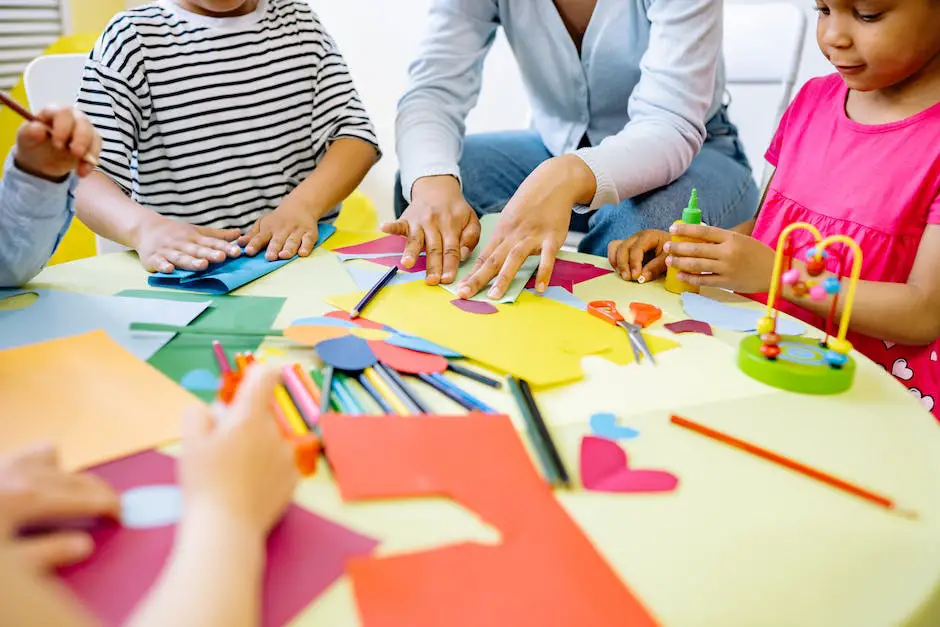What is Creative Curriculum? This article explains this recent development on the teaching and learning process. Read on to find out.
Table of Contents
Introduction to Creative Curriculum
Creative Curriculum Explained
Creative Curriculum is a transformative approach to teaching and learning that has been gaining momentum in recent years. This approach is defined by its integration of traditional academic disciplines with real-world applications, tapping into students’ inherent curiosity to foster an engaging and collaborative learning environment.
Rather than focusing solely on knowledge acquisition, a creative curriculum prioritizes problem-solving, critical thinking, and creativity as keys to lifelong learning. The adoption and implementation of a creative curriculum face both opportunities and possible pitfalls, all of which will be explored in this discussion.
Creative Curriculum is an educational approach that integrates the arts, creativity, and hands-on learning activities into daily lessons, aiming to foster holistic development and promote critical thinking skills. The idea behind this curriculum is to enhance student understanding by allowing them to explore, draw their own conclusions, and express themselves through various mediums such as music, visual arts, drama, and writing.
Read More: Critical Thinking Examples
A creative curriculum is an educational approach emphasizing customization, versatility, and a comprehensive understanding of each student’s learning requirements.
Creative curriculum is an educational approach that integrates the arts, creativity, and hands-on learning activities into daily lessons, aiming to foster holistic development and promote critical thinking skills.
The primary objective of a creative curriculum is to facilitate children’s learning through play, engagement, and exploration. It aims to nurture creativity, promote innovation, develop problem-solving and critical thinking skills, encourage emotional growth, and enhance social skills. Through this approach, students can bear witness to the practical application of theories, relate school work to real-world problems, and be better prepared for the complexities of adult life.
5 Key Principles of Creative Curriculum
There are several principles that govern the implementation of a creative curriculum. These include:
- Learner-Centeredness: The curriculum recognizes each student’s unique learning style, interests, and capabilities.
- Emphasis on Inquiry: Creative curriculum encourages students to question, explore, and discover rather than receive pre-packaged information.
- Integration of Subjects: Creative curriculum promotes interdisciplinary learning and fosters connections among various subjects.
- Emphasis on the Process of Learning: The focus is not just on the learning outcomes but also on the process of learning, which includes critical analysis and self-reflection.
- Respect for Diversity: The curriculum acknowledges and celebrates cultural, racial, and linguistic diversity, and fosters inclusivity.
Pros and Cons of Creative Curriculum
Creative Curriculum has a number of advantages. It facilitates the development of problem-solving and decision-making skills, and nurtures creativity and innovation. This method encourages students to become active learners, allowing them to make meaningful connections between what they’re learning and their own experiences.
However, Creative Curriculum also has its challenges. It requires extensive planning from educators, who must consider each child’s individual learning style and abilities. It might be difficult to assess and quantify student progress using standardized assessments, as the curriculum emphasizes process over product. Finally, it might be a challenge to implement if there lacks adequate resources or staff training.
Creative Curriculum vs. Traditional Curriculum
Compared to traditional curriculum, Creative Curriculum emphasizes real-world relevance, interactivity, and flexibility. Traditional learning often focuses on rote memorization and linear concepts, with an emphasis on passing standard tests. Creative curriculum, on the other hand, stresses problem-solving, creativity, and the ability to think critically in complex situations. Students in a creative curriculum setting are more likely to be engaged, motivated, and interested in their learning.
Examples of Creative Curriculum
One example of a creative curriculum is the integration of arts and literacy. Students might read a story and then use various art forms to explore themes, characters, and plot details.
Another example is the use of project-based learning. Students might investigate a local social issue, collect data, conduct interviews, and tent findings through a multimedia presentation.
In mathematics, instead of traditional worksheets, students might learn measurement and geometry by designing and building 3D models, thereby making math concepts tangible and relatable.
For more detailed lessons, read Three Examples of Creative Curriculum Lessons at different educational levels: K-12, college, and graduate school.

Components of a Creative Curriculum
Project-based Learning
One of the fundamental aspects of a creative curriculum is project-based learning, where students learn by actively engaging in real-world and personally meaningful projects. These projects often integrate multiple subject areas, encouraging a holistic approach to education.
For example, a student might engage in a project to build a miniature town, incorporating elements of math, art, social studies, and language arts.
Cross-curricular Connections
Cross-curricular connections are also essential in the creative curriculum. Subjects are not taught in isolation, rather concepts are interconnected across disciplines, helping students to see the bigger picture. For instance, a lesson on World War II might incorporate historical facts (History), letter writing to soldiers (English), and calculations related to war economies (Mathematics), creating a rounded and in-depth understanding of the subject matter.
Student-driven Learning
Student-driven learning is another key aspect of a creative curriculum. It allows students to actively participate in their educational journey by setting their personal learning goals, choosing the projects they work on, and contributing ideas about how to approach lessons. This fosters a sense of ownership over the learning process and enhances motivation and engagement.
Role of Educators in the Creative Curriculum
In a creative curriculum, educators don’t simply impart knowledge, but act as facilitators of learning. They provide the resources and guidance required for explorative learning, while encouraging students to take the initiative.
Furthermore, educators embrace flexibility, adapting their teaching strategies to cater to the students’ diverse learning styles and interests. They maintain an interactive and dynamic classroom environment where ideas are freely exchanged, and critical thinking is nurtured.
For instance, if students express interest in zoo animals, the educator might facilitate a project where students research different species, craft a campaign on animal conservation, perhaps even organize a field trip to a local zoo. This way, the educator is guiding the learning process while providing students with the autonomy to explore their interests.
Designing a Creative Curriculum
Designing a creative curriculum requires thorough planning and a deep understanding of the learners’ needs. The first step involves identifying clear and concrete learning objectives that align with the required educational standards. The curriculum should take into consideration various factors such as students’ age, skill levels, cultural backgrounds, and learning styles. A key feature of a creative curriculum is flexibility; it must allow for adaptations and changes as needed based on students’ learning progress.
Implementation of a Creative Curriculum
Once the creative curriculum has been designed, it’s crucial that educators are trained to deliver it effectively. This may involve a shift from traditional teaching methods to more interactive, student-led approaches. Teachers should be adept at guiding students through the learning process, enabling them to explore their interests, tap into their creativity, and apply their new knowledge in exciting and innovative ways.
The creativity of educators and the individual needs of students shape the various implementations of a creative curriculum. Using resources such as technology, art, music, and outdoor environments can greatly enhance the implementation of a creative curriculum.
For example, a lesson on environmental science may involve a trip to a local park, where students can observe and interact with nature directly. Meanwhile, technology can be incorporated into a mathematics lesson by using visually engaging apps or software to illustrate complex concepts.
Also, in a science class, students may explore biological and ecological concepts by fabricating a habitat within their school grounds and recording their observations over a certain period. They might even delve into art, producing visual illustrations of their research findings. Or conduct experiments at home using indigenous materials.
Read more: 5 Easy Science Experiments at Home

Conversely, in social studies, students might be asked to pretend as diplomats from various countries attempting to resolve a global crisis. This strategy enables an intermingling of history, geography and interpersonal communication skills.
The ultimate goal of a creative curriculum is to peak curiosity, encourage critical thinking, and instill a passion for learning that is enduring. Students are engaged, stretching their minds to prepare for the fast-paced, continuously evolving world in which we live.
Measuring the Effectiveness of a Creative Curriculum
The effectiveness of a creative curriculum can be measured through various tools and strategies. Observations, student portfolios, teacher assessments, and standardized tests can all provide valuable insights into students’ learning progress and the curriculum’s overall impact.
For example, a teacher might observe that students’ critical thinking abilities have improved based on the complex ideas they’re able to articulate during classroom discussions. A portfolio review might reveal growth in a student’s skills over time, such as heightened interpretive abilities exhibited in their art or literature assignments.
Furthermore, student feedback is a vital tool for assessing the creative curriculum’s success. An open dialogue with students about what they enjoy and what challenges they face can facilitate a classroom environment that values growth, experimentation, and continuous learning.
Spin-Off Effect of Creative Curriculum
The creative curriculum has a profound impact on students and teachers alike. By emphasizing students’ interests and curiosities, the curriculum is more engaging, relevant, and memorable for the learners. This leads to improved student motivation and participation, resulting in better comprehension and retention of knowledge.
For teachers, the creative curriculum shifts the educational approach from lecture-based delivery to a collaborative learning process. This also energizes the teaching profession and enhances their creativity in creating compelling teaching materials that cater to their students’ curiosity.
Conclusion
The Creative Curriculum approach, while not without its challenges, has shown remarkable potential in re-imagining the process of knowledge accumulation and lifelong learning. Through the successful real-world applications depicted in this analysis, it’s evident how this model nurtures creativity, facilitates cross-curricular connections, and fosters student engagement in unique and impactful ways. It incites a paradigm shift from a one-size-fits-all education model to a more customized, learner-centered framework that recognizes and celebrates individuality. Along with diligent planning, resource identification, and teacher training, institutions can leverage Creative Curriculum to redefine success in their education journey for their educators and students alike.



